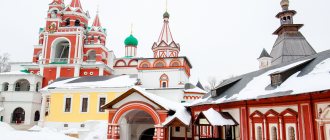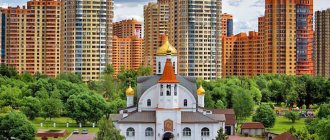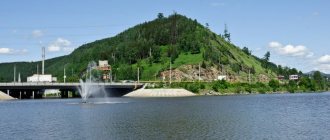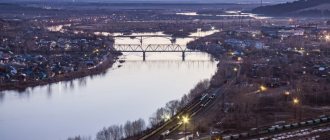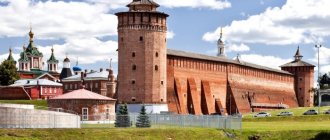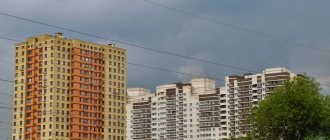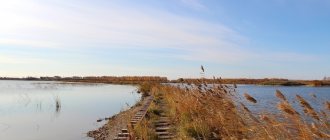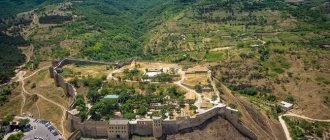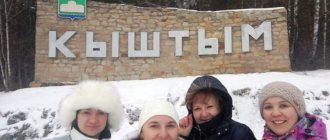Kolomna Kremlin
In the 16th century The Kremlin's stone walls with a perimeter of 2 km replaced the existing wooden ones. Their height reached 21 m, and their thickness was 4.5. Fragments of walls and seven of the originally built 17 towers have survived to this day. It is sad that the townspeople themselves actively participated in the dismantling of medieval walls for building materials. This vandalism was stopped only after a special decree of Nicholas I.
One of the surviving towers is called Kolomenskaya or Marinkina. The second name is associated with the version according to which an active participant in the Time of Troubles, the wife of False Dmitry, Marina Mnishek, was imprisoned and died in it.
Some architectural details, similar to northern Italian fortresses, give reason to believe that the Italian architect Aleviz Fryazin, who also worked in the Moscow Kremlin, participated in the construction of the Kolomna Kremlin.
Kolomna Kremlin
Religious, historical and ordinary residential buildings coexist on the territory of the Kremlin. Here are the Assumption Cathedral, Novolutvinsky and Assumption Brusensky convents and churches - Tikhvin, Resurrection and Holy Cross. In the center of the Kremlin is Cathedral Square. Its architectural ensemble was formed over two centuries by the sequential construction of the Assumption Cathedral, its bell tower, then the gate bell tower of the Novoglutvin Monastery, and, finally, the Tikhvin Church. Already in our century, a monument to the creators of the Cyrillic alphabet, Cyril and Methodius, appeared on Cathedral Square.
To make it easier to move around the rather vast territory of the Kremlin, visitors can rent... scooters. The first hour of rental will cost 200 rubles. for adults, and 150 rub. for children, and every subsequent hour - 100 rubles. There are guided tours around the Kremlin. Its cost for a group of up to 6 people is 1,500 rubles.
Assumption Cathedral in Kolomna
The Cathedral of the Assumption of the Blessed Virgin Mary is much older than the Kremlin. It was founded in the 14th century. after the first victory of Prince Dmitry Donskoy over the Tatars. The return of the soldiers to the city coincided with the day of the Dormition of the Holy Mother of God. Dmitry Donskoy prayed in this cathedral before the Battle of Kulikovo and Ivan the Terrible before his victorious campaign against Kazan.
By the 17th century the cathedral fell into disrepair and had to be dismantled. The new five-domed temple in its place, built by Melenty Alekseev, turned out to be stronger and has survived to this day.
Assumption Cathedral in Kolomna
A five-tier carved iconostasis was installed inside, also preserved.
In the same XVII century. An unusually wide 40-meter hipped bell tower of the cathedral was built. The painting of the temple walls was done at the beginning of the 19th century.
The activities of Saints Job and Philaret, and the clergyman Dimitry Vdovin were connected with the Assumption Cathedral. In 1929 the cathedral was closed, and in 1989 it was returned to the Russian Orthodox Church. 10 years later, after the restoration of the wall paintings, the cathedral was re-consecrated.
The main shrine of the cathedral is the Don Icon of the Mother of God, presumably painted by Theophan the Greek. This relic was with Dmitry Donskoy during the Battle of Kulikovo. Ivan the Terrible prayed before her on the eve of the Kazan campaign. After the capture of Kazan, the tsar took the icon to Moscow. Nowadays it is in the Tretyakov Gallery, and in the Assumption Cathedral since that time the icon has been replaced by its copy.
TOP 5 - what to visit in Kolomna in 1 day
It is customary to start getting acquainted with any city with places that are considered its calling cards. In this case, we will talk about the local Kremlin, the main monastery, monument, park and square in Kolomna.
Kolomna Kremlin
- Opening hours: daily, 24 hours a day.
- Ticket price: admission is free, a sightseeing tour with a guide for a group costs from 1,500 rubles. up to 2500 rub.
- Telephone.
- Website: https://www.kolomna-kreml.ru
- Address: st. Lazhechnikova, 5. Transport stop “Square of Two Revolutions”.
A magnificent monument of medieval Russian fortification architecture, was erected in the first third of the 16th century. in place of a wooden fortress, which was destroyed several times almost to the ground by foreign invaders, including the Horde khans Batu and Tokhtamysh. In terms of size, the citadel, which remained impregnable, is only slightly inferior to the Moscow Kremlin.
Fragments of the powerful fortress wall and 7 of the 16 towers have survived to this day. In addition, the ensemble of the Kolomna Kremlin includes the Novo-Golutvinskaya and Brusenskaya convents, Tikhvinskaya, Krestovozdvizhenskaya, Ascension churches and the Assumption Cathedral.
Cathedral Square
- Address: Old Kolomna district. Transport stop "Market".
The square, considered the heart of Kolomna, to which the main street of the Kremlin opens, began to be built up in the 14th century. There is an amazing atmosphere of peace created by the numerous temples here. On the recreational territory there is a complex of the Novo-Golutvinsky convent, considered the largest in Russia.
The square is framed by the Church of St. Nicholas Gostiny, built at the very beginning of the 15th century, the temples of the Icon of the Mother of God of Tikhvin and the Resurrection of the Slovushchego. The dominant feature of the architectural ensemble is the Assumption Cathedral, built in the 18th century. The architectural composition makes an incredible impression on everyone who saw it for the first time.
Monument to Dmitry Donskoy
- Address: st. October revolution. Transport stop "Square of Two Revolutions".
As you know, it was in Kolomna that Prince Dmitry Donskoy gathered the Russian army, which set out from the city on September 21, 1380 in order to win a great victory on the Kulikovo Field, which put an end to the rule of the Golden Horde over Russia. In the spring of 2007, in honor of this significant event, a monument to the ruler and commander, canonized, was unveiled.
The equestrian bronze statue, 5.5 m high, is placed on a 7-meter granite pedestal. Dmitry Donskoy, riding a faithful steed in battle garb, with his hand to his heart, promises the heavens not to spare his life in the name of liberating the Fatherland.
Staro-Golutvin Monastery
- Opening hours: daily, from 7:30 to 20:00.
- Telephone.
- Website: https://www.starogolutvin.ru
- Address: st. Golutvinskaya, 11. Transport stop "Bochmanovo".
The Epiphany Monastery, also called Staro-Golutvinsky, is the main religious attraction of Kolomna. It was built in the 14th century, and some written sources indicate that the construction of the monastery was directly supervised by the Monk Sergius of Radonezh himself.
The architectural ensemble of the monastery includes the Epiphany Cathedral, the Radonezh Church and the gateway Church of the Presentation of the Lord. Tens of thousands of pilgrims annually visit the monastery to kneel before the Orthodox relics stored within its walls - particles of the Life-Giving Cross and the Crown of Thorns of the Lord, and the relics of saints.
Memorial Park
- Address: st. October revolution. Transport stop "Memorial Park".
During the Great Patriotic War, tens of thousands of citizens went to the front to defend their Motherland, which was subjected to a treacherous attack by a cruel enemy. Many of them gave their lives for the great Victory. In memory of the heroes, a memorial square was laid out in Kolomna.
The Alley of Heroes leads to its center, where a monumental composition with the torch of the Eternal Flame is installed, along which busts of Kolomna residents awarded the highest military regalia of the USSR are located. Several monuments were erected in the recreation area at different times. The memorial park complex includes the Museum of Military Glory.
Tikhvin Church
The Tikhvin Church was originally built in the 18th century. A century later, it was dismantled and a new five-domed one was built in the pseudo-Russian style. From the east it adjoined the bell tower.
Tikhvin Church
The church is named after the icon of the Mother of God, painted by the Evangelist Luke, found near the city of Tikhvin. The new church had three altars: the main one, in the name of this icon, the left one - in honor of Simeon the God-Receiver and Anna the Prophetess, and the right one, dedicated to the icon of the Mother of God “Quench my sorrows”.
During Soviet times, the church was closed, the domes were demolished, and the interior was destroyed. After the church was returned to the believers, Kolomna craftsmen carried out large-scale restoration work. Divine services in the church resumed even earlier than in the Assumption Cathedral.
Novogolutvin Holy Trinity Monastery
On the territory of the current monastery since the 14th century. Kolomna diocese was located. It included the Bishop's House and Corps, the Trinity Church and the Theological Seminary. At the very end of the 18th century. By imperial decree the diocese was abolished. Church authorities promptly transferred the monks of the Epiphany Golutvinsky Monastery to the vacated premises in order to preserve these structures for the church. From this moment on, the Kremlin Holy Trinity Monastery began to be called Novogolutvin, and the city Epiphany - Starogolutvin.
By the middle of the 19th century. New churches and a 55-meter yellow bell tower appeared on the territory of the monastery. During Soviet times, the monastery was closed, but in 1977 its premises began to be restored. A decade later, the monastery was returned to the Russian Orthodox Church, but it became a women's monastery.
The main building of the monastery is the Church of the Holy Trinity in the Russian Baroque style. Elegant windows decorated with crimson trim stand out on the white stone walls. In the background of the photo you can see the top of a beautiful light yellow bell tower.
Novogolutvin Holy Trinity Monastery
The nuns created the mosaic floors and mahogany iconostasis with their own hands. Thanks to the efforts of restorers who removed 12 layers of paint, beautiful 19th-century painting can once again be seen on the walls and ceiling.
In 1990, in the basement of the Trinity Church, a new church was consecrated in honor of Blessed Xenia of St. Petersburg. The church is famous for its unusual ceramic iconostasis made by the nuns.
Now over 80 nuns and nuns live in the monastery, and not only from Russia. They lead a fairly active lifestyle. The monastery has an Orthodox medical center with nun doctors, as well as a dog kennel where rare Mongol-Buryat dogs and Central Asian shepherd dogs are bred and kept. The nuns embroider and work in icon painting, ceramics and carpentry workshops. The church choir travels to services in other churches in Russia, and even beyond its borders.
Address: st. Lazareva, 11A.
Brusensky Assumption Monastery
The foundation of the monastery dates back to 1552, and is associated with the third campaign of Ivan the Terrible against Kazan. It is assumed that the king founded the monastery upon his return from a successful campaign. Initially, most of its buildings were made of wooden beams, so the monastery began to be called “timbered” or “Brusensky”. The first inhabitants of the original monastery were some participants in the victorious Kazan campaign.
Brusensky Assumption Monastery
During the Time of Troubles, the monastery experienced a decline. After the Time of Troubles, the monastery became a convent. Among the nuns there were also persons from noble families. After the abolition of the Kolomna diocese, the Brusensky Assumption Monastery was assigned to the Assumption Tula Monastery, and even the abbess and nuns were moved there. Then, at the request of the Kolomna residents, the Holy Synod reversed its decision.
The heyday of the monastery was the 19th century. During Soviet times, the monastery was closed. Its buildings suffered significant damage, and the nuns were expelled or repressed. Fortunately, large-scale restoration work has returned it to almost its original appearance.
The main building of the monastery is the five-domed Holy Cross Cathedral, erected in the mid-19th century. It became an adornment not only of the monastery, but of the entire Kremlin. White stone carved details stand out on the red brick walls of its façade.
The main relic of the Brusensky Monastery was a copy of the Kazan Icon of the Mother of God, lost in Soviet times. The list has now been recreated based on a copy found in the archives.
Address: Brusensky lane, 36.
Epiphany Starogolutvin Monastery
In the 15th century, at the confluence of the Oka and the Moscow River, the Epiphany Golutvin Monastery was founded. It is believed that this event occurred with the participation of Dmitry Donskoy and Sergius of Radonezh after the conclusion of peace between the two Russian principalities - Moscow and Ryazan. The unusual name is associated with the Golutvino area. It is assumed that the word “golutva” means a forest clearing (on the road from Kolomna to the Oka crossing).
Epiphany Starogolutvin Monastery
At the very end of the 18th century, after the abolition of the Kolomna diocese and the transfer of part of the brethren to the territory of the Kremlin, the monastery began to be called Starogolutvin. Its main temple is the Epiphany Cathedral. The current men's monastery also houses the Church of St. Sergius of Radonezh and the Vvedensky Gate Church.
Monastery address: st. Golutvinskaya, 11. It is open to the public, and donations are welcome.
Bobrenev Monastery of the Nativity of the Virgin Mary
This monastery is located in the village of Staroye Bobrenevo adjacent to Kolomna on the other bank of the Moscow River. Its panorama is clearly visible from the Kremlin Cathedral Square.
Bobrenev Monastery of the Nativity of the Virgin Mary
The monastery was built by Dmitry Donskoy as gratitude to the Mother of God for the victory in the Battle of Kulikovo. In the 18th century The monastery lost its independence and became part of Novoglutvin. In the next century, the blue and white Feodorovskaya Church was built on the territory of the monastery. It houses the famous icon of the same name of the Mother of God, which was considered the patroness of the Romanov royal dynasty. (That is why, when adopting Orthodoxy, non-Russian wives of autocrats received the patronymic “Feodorovna.”)
There are two main churches in the monastery - the Nativity of the Virgin Mary (in the background) and Feodorovskaya. The acoustics of the Church of the Nativity of the Virgin Mary is unique: it creates the illusion of polyphonic singing.
The monastery is free to visit: donations are welcome.
Useful tips for your stay in Kolomna
There are no special rules for staying in Kolomna. But there are some tips for tourists who are going to visit this city for the first time:
- It’s better to sign up for excursions to museums in advance, as there can be a lot of tourists and you won’t be able to get through the queue (especially on weekends);
- Many places for recreation and entertainment accept bank cards, so you don’t have to take a lot of money with you;
- Most of the attractions are located in the historical center of the city, so it’s better to start exploring the city from the Kremlin;
- since most of the listed objects are located within the city, you don’t have to take many things with you (it’s better to take a backpack - in case you want to buy souvenirs or, for example, marshmallows for your relatives);
- In order not to waste time moving between attractions, it is better to make a plan for a walk around the city in advance;
- For convenience, you can take a pre-prepared map with you.
On the map you can mark in advance exactly the places you plan to visit
Church of John the Baptist in Kolomna
The Church of the Conception of John the Baptist was built a long time ago - at the beginning of the 14th century. in the village of Gorodishche, now part of the city.
To the left of the entrance on the wall of the church you can see a bas-relief called the “Kolomna Beast”. The original bas-relief, now located in the Kolomna Museum of Local Lore, oddly enough, belonged to the famous Golden Horde Khan Batu. In 1238, even before the construction of the temple, Prince Roman of Ryazan died in a battle with it.
The Khan was so admired by the courage of his enemy that he ordered him to be buried with honor according to Orthodox custom, and gave his security sign to his grave and the future church.
Church of John the Baptist in Kolomna
The current Church of St. John the Baptist has partially preserved its original appearance. The greatest value is the ascetic iconostasis, made on rough boards. The only surviving icon is “John the Baptist. Angel of the Desert,” is kept in the vaults of the Tretyakov Gallery. The church also contains components rebuilt and added to in the 16th and 18th centuries.
Address: st. Gorodishchenskaya, 102A. You can get to the church by city buses No. 1, 10 and 17: you should get off at the “Gorodishche” stop.
Church of the Archangel Michael in Kolomna
Erected in 1700 on the site of an existing wooden one, the stone Church of the Archangel Michael is the largest in Kolomna. The current appearance of the building is the result of a radical reconstruction in the 19th century.
During the unfavorable Soviet times for many churches, the Local History Museum operated in the church, thanks to which serious damage to the facade was avoided. Much less fortunate was the interior of the church and its bell tower, which was restored almost from scratch. Now inside the church there are a few icons and the Palekh iconostasis.
Church of the Archangel Michael in Kolomna
The appearance of the church is quite unusual. The poppy is mounted not on a drum, but on a rotunda. The entrance to the church resembles the front porch of a palace or theater.
Address: st. Civil, 71 (not far from the Kremlin).
What to see in different seasons
The Kremlin, monasteries and monuments are beautiful at any time of the year; natural attractions are especially beautiful in the fall. In winter it is convenient to visit museums and ancient estates. By the way, some estates have especially beautiful landscapes in winter (you can admire the Russian winter and take great photos). But Kolomna also hosts seasonal events, for example, the Antonov Apples festival.
Festival "Antonov Apples"
“Antonov Apples” is an international festival in Kolomna (it is also called the apple and book festival, since one of the areas of the holiday is literary reading). Main event venues:
- book Fair;
- children's pavilions (for example, "Children's Market" - a handicraft area);
- master classes from leading Kolomna publishing houses;
- museum sites;
- library on the water (“Book Boat”);
- “City Lunch” (outdoor picnic);
- creative workshops and charity events;
- concert program, etc.
Each year, the “Apple Express” (a special themed train that departs from the Kazansky railway station in Moscow) becomes a separate venue for the event. The conductor is a guide introducing passengers to the holiday program. In addition, each passenger can take part in special competitions.
The main action takes place in the historical center of Kolomna (not far from the Kremlin).
Video: story about the festival
Church of St. Nicholas on Posad
Another original religious building is the Church of St. Nicholas on Posad.
The building in the style of the Moscow pattern looks like a fairy-tale tower. In its upper part there are 105 carved stone kokoshniks. Not only the building is unusual, but also the services held in it: after all, the church belongs to the Old Believers.
In the chronicles of the late 16th century. the wooden church of St. Nicholas the Mokroy is mentioned in the suburb (i.e. outside the then city walls). Nicholas the Wonderworker was called “wet,” apparently after the icon in which he saves a baby who has fallen into the water. The stone church on this site was built at the beginning of the 18th century. For an unknown reason, the “highlights” of the building - kokoshniks and platbands - were destroyed at the end of the same century, and restored... in Soviet times. True, in the 30s of the XX century. icons and interior frescoes were lost.
Church of St. Nicholas on Posad
Visitors are allowed inside the church only during services. The interior is not impressive: only the unusual service can arouse interest. Admission is free, but donations are welcome.
Address: st. Posadskaya, 18 (not far from the marshmallow and kalachi museums).
"Kolomenskaya pastila"
The “Museum of Vanished Taste” is located in an old wooden house, where in the 19th century. There was a confectionery shop of the merchant Suranov.
It doesn't really live up to its name. Rather, it is a museum marshmallow factory. After observing the process of making the delicacy, a tea party with freshly prepared marshmallow follows. Their own taste buds convince visitors that the taste of marshmallow is not lost at all, but is quite real. Few tourists leave without a souvenir in the form of a beautifully packaged marshmallow.
"Museum of Vanished Taste"
Tourists visiting the museum will learn that in the production of classic marshmallows, only sour varieties of apples are used - Antonovka or Titovka. Fruit pulp puree is mixed with egg whites and honey and whipped. After drying, the pastille strips are sent to the oven. After removal, the delicacy is cut into strips and sprinkled with powdered sugar.
Address: st. Posadskaya, 13A (not far from the Kremlin and the Church of St. Nicholas on Posad). Opening hours: daily, from 10 to 20 hours. Ticket price on Mondays – Fridays – 350 rubles. for adults and 300 for children. On Saturday and Sunday the price is higher - 450 and 400 rubles, respectively.
What to see if you come with a child
Some children do not like “museum” walks. To entertain an inquisitive child, you can visit the following attractions:
- skating palace;
- wall with drawings;
- marshmallow factory;
- "Giant roller coaster"
Skating Palace "Kolomna"
The Kolomna Skating Palace is a sports complex that is one of the most popular Russian skating rinks. It was opened in 2006. It was in this palace that the Ice Age show was filmed. Both children and parents will be interested in visiting one of the ice shows, and the most active guests can go ice skating (singlely or as part of a group). Tickets cost from 100 rubles (children under 10 years old are free).
The ice palace has other areas (boxing ring, tennis court, fitness room, etc.)
The Kolomna Palace is located at the address: Naberezhnaya Kolomenki Street, 7.
Wall with drawings
All children love color pictures. In Kolomna there is a wall (the fence of an ordinary car repair shop) decorated with humorous graffiti. No other city in Russia has such a “street” attraction. The fact is that both the sayings and the drawings themselves are dedicated only to the Kolomna residents. This way, city guests can get to know the culture of Kolomna better.
It is not known who decorated this wall and in what year, but the authorities are not removing it, which means the wall deserves attention.
Each drawing on the wall is dedicated to Kolomna residents
A wall with drawings can be found on Zaitseva Street (not far from the pontoon bridge).
Pastila Factory
The pastila factory in Kolomna is a small factory for the production of sweets, opened in 1852. The object belonged to the merchant Karp Chuprikov. The factory is also called a museum of vanished taste, although it only became a museum in 2011. In addition to the fact that you can buy rare sweets here, guests are offered other services:
- master classes on making confectionery products;
- theatrical performances throughout the year;
- tours of the factory with the history of its origin;
- free coffee and Wi-Fi;
- visit to the “Garden of Kolomna Pastilnitsa”, etc.
The factory will be interesting for both children and their parents. However, the visit must be agreed upon in advance and paid for (tickets cost from 200 rubles). Information about ordering a ticket can be obtained on the official website of the enterprise (https://kolomnapastila.com). Museum factory opening hours: daily from 10 am to 8 pm. Factory address: Polyanskaya street, 4.
Video: story about the marshmallow factory in Kolomna
A complex of giant wooden slides and swings
A complex of giant slides can be an interesting entertainment for a child and his parents. This facility was built in 2008, its elements were used to host the European Winter Sports Championships. The championship passed, but they decided to leave the wooden slides and swings, because this is not only a playground, but also a large-scale art object. By the way, various city events are held on the territory of the complex (especially often in winter). You can come to the slides at any time and completely free of charge; the area is not fenced in anything. The complex is located on Levshina Street (city center).
The complex of giant slides and swings are wooden buildings for sports and entertainment purposes.
Museum "House of the Samovar" in Kolomna
In the next building there is a samovar museum.
Contrary to popular belief, Russia is not the birthplace of samovars.
The samovar, invented in China, appeared in Rus' only in the middle of the 18th century, but immediately became familiar. Already at the end of the same century, 120 thousand samovars were produced in Tula per year.
Samovar House in Kolomna
The basis of the museum exhibition is the private collection of the Kolomna Burov family.
In addition to four hundred different samovars, here you can see other items of former everyday life - irons, kerosene lamps, a Russian stove, spinning wheels, and ancient clothes. The café at the museum serves authentic Russian dishes based on homemade recipes.
Address: st. Posadskaya, 11. The museum is open from 10 to 18 (on Saturday and Sunday - until 19) hours. The cost of an “adult” ticket is 400 rubles, and a “children’s” ticket is half that.
Where to go in Kolomna and what else to see:
Kolomna Local Lore Museum
Kolomna Local Lore Museum
From its foundation in 1936 until 2005, it occupied the building of the Church of the Archangel Michael. In 2006, the museum's funds were transported to a magnificent merchant estate built in the mid-19th century.
The local history museum has more than 25 thousand exhibits introducing guests to the history, nature and culture of Kolomna. The walls of one of the exhibition halls are decorated with paintings by famous Russian painters Aivazovsky, Vasnetsov and Pimenov.
The pride of the Kolomna Local Lore Museum is its collection of archaeological finds dating back to the Bronze, Stone and Iron Ages.
Address: Kolomna, st. Lazhechnikova, 15
Opening hours: daily from 10:30 to 16:30, from Monday to Tuesday and on the last Friday of each month, the museum is closed
Entrance: for adults – 40 rubles, for children – 25 rubles.
Official website: https://kolomnamuzej.ru/
Museum of Organic Culture
Museum of Organic Culture
One of the most visited places in the city, attracting the attention of fans of Russian art. The museum is located on the site of the former estate of the Ananyin family. Subsequently it belonged to the merchant Lvov.
In 2011, a decision was made to assign the building the title of cultural and historical monument. Inside there are several hundred paintings by contemporary artists working in certain styles that preserve the main traditions of the Russian avant-garde.
The exhibitions will allow you to get closer to the concept of organic culture. The building where the gallery is located is also interesting from an architectural point of view.
Address: Kolomna, st. Kazakova, 10
Opening hours: Wednesday – Sunday, from 12:00 to 18:00
Entrance: ticket price per person – 200 rubles.
Official website: https://museumart.ru/
Skating
Skating
The largest multifunctional sports complex in the Moscow region. On an area of 70 thousand m2 there is an ice arena, a gym and games room, a pneumatic shooting range, an outdoor stadium, a medical center for rehabilitation and prevention, a large swimming pool, an office space for the press center, a beautiful winter garden, a mini hotel and a cafe.
The ice arena is one of the most visited and fastest skating rinks in the world. International competitions have been held here several times, and Russian speed skating championships are held every year.
The stands can comfortably accommodate more than 6 thousand visitors. The Winter Garden is also of interest to tourists.
Address: Kolomna, emb. Kolomenki River, 7
Opening hours: You can purchase a ticket at the box office any day. On weekdays - from 8:30 to 20:45, on weekends - from 8:30 to 19:45
Entrance: visiting the pool - 180 rubles, skating - 200 rubles, rental - 120 rubles.
Official website: https://kolomna-speed-skating.com/
Museum of Military Glory
Museum of Military Glory
Located in Memorial Park, in an interesting building with a red facade representing the Victory Banner. The spacious exhibition halls display several exhibitions that introduce visitors to the military history of the city from different periods. Most of the exhibits were kept in the home archives of townspeople for a long time.
Particularly noteworthy is the diorama - an 82-mm mortar, the design of which was created by employees of the Kolomna Engineering Bureau. The pearl of the exhibition is the electronic Memory Book.
Address: Kolomna, st. Invincible, 1
Opening hours: Wednesday – Saturday from 10:30 to 16:30. Sunday, Monday and last Friday of the month are days off
Entrance: 100 rubles, discount ticket – 50 rubles. Children under 6 years old – free
Official website: https://kolomna-memorial.ru/
Museum "Kalachnaya"
Museum "Kalachnaya"
The unusual and most “tasty” museum of Kolomna is located in a beautiful building erected in the first half of the 19th century. The founders tried to recreate in the hall a warm atmosphere corresponding to the life of the 19th – 15th centuries.
In a double-hearth Russian oven, built by modern craftsmen according to ancient drawings, the most aromatic and appetizing rolls in the Moscow region are baked. The dough for the famous pastries is prepared according to ancient Russian recipes, and in order to give the finished products a delicate light crust, the oven is heated only with birch firewood, cleared of bark.
During the theatrical excursion, visitors will learn many interesting facts about the history of the appearance of kalach, the secrets of the dough and see all the stages of preparation. After visiting the museum, guests should stop by the shop where you can buy freshly baked kalach.
Address: Kolomna, st. Zaitseva, 14
Opening hours: daily from 10:00 to 20:00
Entrance: for adults – 400-500 rubles, for children – 300-400 rubles.
Official website: https://kolomnakalach.ru/
Museum "Kuznechnaya Sloboda"
Museum "Kuznechnaya Sloboda"
Numerous exhibitions feature wooden and forged objects that were created by talented craftsmen several centuries ago. Stored within the walls of the museum are dozens of types of all kinds of weapons, previously used armor of warriors and household utensils previously used by local residents.
Kuznets I.G. Lebedev is considered the founder of the museum. He was the first to begin collecting a collection of rare exhibits, traveling throughout the country. In the future, he furnished the mansion in the appropriate style and opened a museum that allows you to get acquainted with the culture of the Kolomna region.
Address: Kolomna, st. Grazhdanskaya, 84
Opening hours: daily from 10:00 to 18:00, closed on Mondays
Entrance: 100 rubles, excursion – 1000 rubles.
Official website: https://xn--80aacmclulpbnb9aw7d8g.xn--p1ai/
House of Posad Crafts
House of Posad Crafts
The art workshop is located near the Pastila Museum. The venues host several permanent exhibitions and temporary ones.
Visitors have a unique opportunity not only to learn interesting facts about traditional Kolomna crafts, but also to attend master classes in pottery, toy making, or temporarily become a real blacksmith.
There is a forge in the House of Posad Crafts. In the souvenir shop, those interested can purchase memorable gifts made by the owners of the art workshop.
Address: Kolomna, st. Posadskaya, 12
Opening hours: on weekdays - by appointment, on weekends - from 12:00 to 18:00
Entrance: for adults – 150 rubles, for children – 100 rubles.
Museum-residence “Artkommunalka. Erofeev and Others"
Museum-residence “Artkommunalka. Erofeev and Others"
One of the most extraordinary and interesting museums in the city. Visitors have the opportunity to visit a real communal apartment, where the interior fully corresponds to the Soviet era.
The museum has several exhibition halls and a stage where modern interactive games and performances take place. An art residence is equipped in a separate room, where artists and writers live and create from time to time.
Address: Kolomna, st. October Revolution, 205
Opening hours: daily from 10:00 to 20:00
Entrance: 200 rubles, excursion – 300 rubles.
Official website: https://artkommunalka.com/
Museum of Origins “This money is Kolomsk”
Museum of Origins “This money is Kolomsk”
The landmark is located in the Pyatnitskaya Tower. The opening of the museum was initiated by local historian and numismatist M. Amosov.
The museum consists of 2 levels. On the top there is a hall dedicated to the history and traditions of the Kolomna lands. Significant coins for Rus' are stored here in separate display cases: a coin of the Golden Horde, a Kolomna pullo, a coin of Vasily III, a pound of Uzbek Khan.
On the first level (basement) you can see items that were used as means of payment in Rus' in the 10th century. A collection of famous treasures and ancient piggy banks are also exhibited here.
Address: Kolomna, st. Zaitseva, 14
Opening hours: daily from 10:00 to 20:00
Entrance: 200 rub.
Museum "Secrets of Kolomna mead"
Museum "Secrets of Kolomna mead"
Kolomna has been considered a beekeeping center since ancient times. Visitors to the interactive museum will learn all about the valuable qualities of honey, the secrets of preparing ancient Russian drinks, the main ingredient of which is honey.
Guests will enjoy a fascinating and interesting excursion “Secrets of Kolomna mead”. Tourists will learn not only the secret of the name mead, but will also see all the stages of preparing a truly Russian drink, and will also become participants in a luxurious feast. Those interested can walk through the forest with a beekeeper and learn to distinguish real honey from fake.
Address: Kolomna, st. October Revolution, 182 A
Opening hours: daily from 9:00 to 19:00
Entrance: for adults – 300 rubles, for children – 250 rubles.
Official website: https://medovusha.ru/
Private gallery “Museum of your favorite toy”
Private gallery “Museum of your favorite toy”
A unique museum opened in the city in 2014. Its founder was a local resident and collector, Irina Kulikova. The owner collected the teddy bears, dolls, and games presented in the exhibition hall for several years.
The oldest exhibit is a doll made in 1890. The remaining toys were made by craftsmen of the late 19th – early 20th centuries. In the museum you can see Teddy bears created by Kulikova. It was these funny animals that gave the founder the idea of opening a Museum of her favorite toy.
Address: Kolomna, st. Posadskaya, 11
Opening hours: Thursday - Friday - by appointment, Saturday - Sunday from 11:00 to 18:00
Entrance: ticket – 250 rubles, excursion – 800 rubles.
Official website: https://www.kolomnatoy.ru/
Estate of the Lazhechnikov merchants
Estate of the Lazhechnikov merchants
The building, built at the turn of the 18th-19th centuries, houses one of the many branches of the city local history museum. The exposition of the exhibition halls is dedicated to the famous writer I.I. Lazhechnikov.
Museum guests will be treated to a fascinating excursion in the form of an interactive performance. In Part I, visitors will learn interesting facts about the life and activities of the owner of the estate, and in Part II - the secrets of preparing the famous Kolomna delicacy - pastila.
Address: Kolomna, st. October Revolution, 192 A - 194
Opening hours: Wednesday – Sunday from 10:30 to 16:30. From Monday to Tuesday and on the last Friday of the month the estate is closed
Entrance: 100 rub.
Museum of Flax and Life of Russian Women
Museum of Flax and Life of Russian Women
Numerous exhibitions located in a two-story building present rare items collected by Kolomna native N. Ryabtseva. First, the woman became the owner of a small flax store, after which she decided to open a museum that anyone can visit.
During the excursion, guests will see items of home textiles and will be able to touch ancient spindles, spinning wheels and other types of weaving equipment. Several dozen folk costumes are collected within the walls of the museum.
Address: Kolomna, Square of Two Revolutions, 1
Opening hours: daily from 9:30 to 19:00
Entrance: without a guided tour – 150 rubles, with a guided tour – 250 rubles.
Museum-Estate “House of the Samovar”
Museum-Estate “House of the Samovar”
Numerous exhibitions present a private collection of the Burov family's everyday life. The excursion will give you the opportunity to get to know Russian culture better, visit a real Russian hut and learn more about samovars, their differences and methods of use.
Within the walls of the museum there are collected about 4 hundred different types of samovars, in addition, visitors will get acquainted with other ancient objects. These include various kitchen utensils. In one of the rooms there is a traditional Russian stove.
On the territory of the complex there is also a decorated cafe, where you can try dishes prepared according to family recipes.
Address: Kolomna, st. Posadskaya, 11
Opening hours: Monday to Friday from 10:00 to 18:00, on weekends - until 19:00
Entrance: for adults – 400 rubles, for children – 200 rubles. Up to 7 years – free
Official website: https://domsamovara.ru/
Ozerov's House
Ozerov's House
The cultural center occupies a beautiful building in the classicist style, considered one of the most perfect monuments of civil architecture in Kolomna. The landmark was named in honor of the Honorary Citizen of the city, merchant of the 1st guild A. S. Ozerov, who was the last to own the mansion.
The first exhibition was held in 1980, and to date there have been more than 800 of them.
There are permanent exhibitions in the Ozerov House: The Epic Cycle (works by K. Vasiliev), Here is the Russian Spirit (wooden sculptures by A. Leonardov), an exhibition dedicated to the life and work of the artist M. Abakumov.
Address: Kolomna, st. Krasnogvardeyskaya, 2
Opening hours: daily from 8:00 to 20:00
Entrance: 100 rubles, discount ticket - 50 rubles.
Official website: https://www.domozerova.ru/
Pastila Museum
Pastila Museum
In 2008, an unusual museum opened its doors, where anyone can learn the process of preparing the popular sweet and even try it. It is located on the site of a former merchant shop, which was built in the 18th century.
The museum complex includes a production workshop and laboratory, a gift shop and a garden. Museum staff introduce visitors to the methods of preparing different types of marshmallows. Recipes for sweets have been passed down from generation to generation, but their technique has never changed.
At the end of the tour, guests will have tea and tasting. After visiting, everyone can buy souvenirs and take photos.
Address: Kolomna, st. Posadskaya, 13a
Opening hours: daily from 10:00 to 20:00
Entrance: for adults – 400 rubles, for children – 300 rubles. On weekends the cost increases by 100 rubles.
Official website: https://kolomnapastila.ru/
Museum "Kolomensky Gramophone"
Museum "Kolomensky Gramophone"
It was no coincidence that the original museum appeared in Kolomna, because the All-Union Gramophone Factory was opened here in 1933. The opening ceremony of the museum took place on May 1, 2022 and was timed to coincide with a historical event - on this day in 1934 the first 10 gramophones were assembled.
The museum's collection includes not only portable gramophones created in the workshops of the Kolomna Gramophone Factory, but gramophones, music boxes, phonographs created by masters from different countries. During the tour, visitors can enjoy the sound of the exhibits.
Address: Kolomna, st. Lazhechnikova, 3a
Opening hours: Wednesday – Sunday from 11:00 to 17:00, Saturday – from 10:00 to 19:00, Monday and Tuesday – days off
Entrance: for adults – 200 rubles, for children – 100 rubles.
Official website: https://xn--80ajbkfdbgjlfcbim2aw1b.xn--p1ai/
Museum "Kolomensky Kalach"
Similar to Kolomenskaya Pastila, this establishment is a symbiosis of production, museum and cafe.
Museum "Kolomensky Kalach"
The history of the production of rolls dates back to the 16th century. The kalachniks who baked them were considered the bread elite, into whose guild ordinary bakers were not allowed. Visitors also get acquainted with versions of the origin of the most common weight-bearing rolls in former times. It was believed that the hole was used to hang it on a fixed horizontal stick in the pantry, making the rolls out of reach of mice. According to another version, this form allowed ordinary people to eat a “weight” while working without washing their hands, and then throw away the holding “handle.”
The Kalachnaya Museum is located in a restored stone mansion from the 19th century. To bake kalachi, a double-hearth Russian oven is used, heated exclusively with birch firewood. The culmination of the excursion is tasting kalachi with butter and tea.
Address: st. Zaitseva, 14, opening hours: from 10 to 18 hours. Ticket price – 350 (on weekends and during the high tourist season – 400) rubles. There is an additional fee of 250 rubles for the excursion.
How much time does it take to explore the city?
Sights within the city can be explored in 1–2 days. Some tourists make a walk plan in advance and manage to explore the selected objects in a few hours, but if you plan to visit every museum, all monasteries and monuments, then you may need 3-4 days.
Is it necessary to check into a hotel?
It is advisable to check into a hotel if you spend at least 1 night in Kolomna. There are many hotels in the city, since it is part of the “Golden Ring” (Kolomna is a tourist city).
What else to see in Kolomna
If you have time left, you can visit a few more places:
- Kalachnaya Museum;
- Severka gateway;
- monument to Dmitry Donskoy
Museum "Kalachnaya"
“Kalachnaya” is a baking museum opened in Kolomna in 2013. This place is worth visiting for several reasons:
- it tells about the ancient Kolomna kalak craft;
- visitors are offered an excursion to a reconstructed antique but functioning bakery;
- Anyone can take part in the production of fragrant and crispy rolls, the recipe of which is kept in the strictest confidence.
“Kalachnaya” is not just a museum, but also a modern store, as well as a workshop.
The museum is located at 14 Zaitseva Street. Its doors are open from 10 am to 8 pm, and a tour costs from 300 to 450 rubles.
Gateway "Severka"
The Severka lock was built in 1877. It took 3 whole years to build, but this was necessary to improve navigation, because at that time water transport in Kolomna was considered one of the most popular. Over time, the gateway fell into disrepair, and in 1924 it was reconstructed. For this purpose, architects and builders were invited from France (“Tower Society”).
City residents and tourists come to the gateway to enjoy the beautiful views and breathe in the fresh river air. On the river bank next to the lock there is a wooded area where you can have a picnic or pitch a tent.
The gateway, as it is now, is about 100 years old, but nevertheless this place is loved by local residents and visitors to the city
“Severka” is located 2 km from the city limits (you can take a taxi along the M5 highway or walk).
Monument to Dmitry Donskoy
The monument in honor of Prince of Moscow Dmitry Donskoy was erected in 2007. Kolomenets are very sensitive to the history of their city, which is why this monument is especially popular. The initiator and sponsor of the construction of the monument was the city administration. The monument represents a bronze figure of a prince sitting on a horse. The statue is installed on a marble pedestal, on which there is a corresponding inscription.
It was Saint Prince Dmitry who led his army (150,000 soldiers) against the army of Mamai, and the battle was won. The Battle of Kulikovo took place on the banks of the Don River, so the prince was given the nickname “Donskoy”.
The monument to Dmitry Donskoy was created by sculptor Alexander Rukavishnikov.
The monument is located two steps from the Kremlin wall (from the side of Lazarev Street).
"Secrets of Kolomna mead"
Medovushey in Rus' was a cellar for storing honey-based supplies and ripening honey-based intoxicating drinks, in particular mead.
There was such a cellar in almost every boyar or merchant house. The “Secrets of Kolomna mead” museum is located in the restored wine cellars of a 19th century merchant house.
Museum "Secrets of Kolomna mead"
The museum is a kind of symbiosis of antiquity and modern technology. Guests who descend into the cellar are greeted by a virtual housekeeper-guide and a very real mead maker.
After a story about the honey traditions of Kolomna, visitors, under the guidance of a mead maker, prepare honey whipping and taste different types of honey. After this, in the Golden Hive store you can purchase honey products - gingerbread, syrups, balms, wines.
Address: st. October Revolution, 182A, opening hours - from 9 to 19 hours. The visit is carried out in the form of group excursions. Individual tourists can join one of the groups by pre-registering on the museum’s website (medovusha.ru) or by calling the numbers listed there. The cost of the excursion for adults is 350 rubles, and for children – 250.
Museum of Favorite Toys in Kolomna
In 2014, another private museum was opened in Kolomna based on the collection of needlewoman Irina Kulikova.
The museum is a real haven for children. It will be pleasant for adults to return to their own childhood, even for an hour.
Museum of Favorite Toys in Kolomna
In addition to dolls, bears, soldiers, miniature furniture and dishes, rocking horses, you can see antique dolls made in Gzhel, Gudkov and Dunaev.
Address st. Posadskaya, 11, 2nd floor. The museum is open on Saturdays and Sundays from 11 a.m. to 6 p.m. Visits are also possible on Thursday and Friday, but by appointment. An individual inspection will cost 200 rubles, and a guided tour will cost 500.
The best attractions in the vicinity of Kolomna:
Bobrenev Monastery
Bobrenev Monastery
A few kilometers from the city lies the oldest monastic monastery in this region. The exact date of construction of the building is unknown; it was presumably built at the end of the 14th century by order of Prince Donskoy. Subsequently, several more churches made of stone and outbuildings appeared around the monastery.
An amazing place that helps you forget for a few hours and completely immerse yourself in an atmosphere of peace. The building is not only an important church building, but is also considered a valuable historical and architectural monument.
Address: Kolomna urban district, village of Staroye Bobrenevo
Working hours: Tuesday-Sunday from 9:00 to 18:00, Monday - day off
Free admission
Official website: https://bobrenev.ru/
Museum "Kuznechnaya Sloboda"
Another relatively young Kolomna museum is “Kuznechnaya Sloboda”, opened in 2010.
The museum's exhibition includes seven thousand blacksmith items. Their best examples approach the level of art. Here you can see military armor from the pre-Mongol period to the last century, as well as former household items - scales, old kettles, irons.
Museum "Kuznechnaya Sloboda" in Kolomna
Address: st. Grazhdanskaya, 84. Trams No. 1, 3, 7 and 9 go here. There is no fee for visiting, but tourists can leave a donation if they wish.
Best hotels in Kolomna
Related materials:
- 33 attractions of Bakhchisaray that are worth visiting
- 29 best attractions in Orel,…
- 38 sights of Pskov recommended for…
- 31 attractions of Novorossiysk to visit
- 37 must-see attractions in Dubai
- 26 attractions of Svetlogorsk that…
- 40 attractions in Limassol that are worth seeing
- 37 attractions of Sukhum that are worth seeing
- 43 best attractions in Minsk,…
Did you like the article? Share with friends:
2
Estate of the Lazhechnikov merchants in Kolomna
One of the founders of the Russian historical novel, a native of Kolomna, Ivan Lazhechnikov, belonged to a local merchant dynasty. In the middle of the 18th century. The Lazhechnikovs began building an estate near the Kremlin. In the 19th century the estate was significantly expanded. Its preserved main building now houses a cultural museum.
Estate of the Lazhechnikov merchants in Kolomna
In addition to exhibits related to the history of the Lazhechnikov family, household items from bygone Rus' are widely represented here. Grips, scales, and antique furniture coexist with costumed performances and modern interactive programs.
Address: st. October Revolution, 192A-194. Opening hours: Wednesday – Sunday 10:30–16:30, except the last Friday of the month. You need to pay 100 rubles for entry.
Architectural and historical places of Kolomna
Sightseeing hunters will have plenty to see in Kolomna. Among the many cultural heritage sites in the city, there are notable architectural structures and magnificent monuments.
Pyatnitsky Gate
- Address: Kolomna Kremlin. Transport stop "Market".
The main gate of the Kolomna Kremlin, above which a powerful tower rises, got its name from the small chapel of Paraskeva Pyatnitsa, which collapsed over time and was restored in the first third of the 18th century. The fortification structure with high loopholes and a wide arched passage is impressive in size.
The height of the tower, topped with a pointed tent, is 29 meters, length 22, and width 14 meters. On the entrance side, a figured niche was created in the volume of the building, under the arches of which a carved icon and bas-reliefs with figures of saints were previously located. It’s simply impossible not to take a photo against the backdrop of this colorful Kolomna landmark.
Ozerov's House
- Opening hours: daily, from 10:00 to 18:00.
- Ticket price: adult 60 rubles, reduced price 30 rubles, excursions from 50 rubles. up to 100 rub.
- Telephone.
- Website: https://www.domozerova.ru
- Address: st. Krasnogvardeyskaya, 2. Transport stop "Old Kolomna".
The magnificent building, more like a palace than a bourgeois mansion, is considered one of the architectural pearls of Kolomna. It was erected at the very beginning of the 19th century. for the family of a wealthy wine merchant A. Ozerov.
The central portal of the house with arched niches of the main entrance is decorated with a high portico supported by six massive white columns, the luxurious capitals of which immediately attract the eye.
Tourists will be able to admire not only the exterior of the mansion, but also see several permanent museum exhibitions housed in its halls. In addition, concerts are regularly held here and an art salon operates.
Monument to Sergius of Radonezh
- Address: Old Golutvinsky Monastery. Transport stop "Bochmanovo".
The monument to the most revered saint of the Russian land, who with all his might contributed to the unification of the appanage principalities around Moscow, did not appear in Kolomna by chance. It was Sergius of Radonezh who convinced the Ryazan prince Oleg to conclude eternal peace with Dmitry Donskoy.
In honor of this event, the Epiphany Monastery was founded near Kolomna, the construction of which the monk supervised. The sculptor depicted the saint with a staff in one hand and blessing the inhabitants of the city with the other hand. The statue was installed on the territory of the Staro-Golutvinsky monastery in front of the Epiphany Cathedral.
Lazhechnikov Estate
- Address: st. October Revolution, 194. Transport stop “Square of Two Revolutions”.
The estate was built for the successful merchants Lazhechnikov brothers in the middle of the 18th century. and expanded six decades later, it is one of the city's main architectural attractions. A two-story merchant mansion with an elegant Moscow-style porch looks more like a country house.
There is a well-kept park around the main building, limited by a fence of forged peaks, arranged in spans, fixed between antique columns of supports. You can enter the estate through a magnificent gate with a driveway and two arched passages. The main building was transferred to the jurisdiction of the Museum of Local Lore.
Monument to Cyril and Methodius
- Address: Cathedral Square. Transport stop "Market".
During the celebrations of the Day of Slavic Literature in the spring of 2007, a monument to its founders was solemnly opened on the Cathedral Square of Kolomna.
The composition, cast in bronze, depicts saints with halos above their heads, standing against the background of an Orthodox cross. Methodius is holding a Bible in his hands, and Cyril is holding a scroll containing the letters of the alphabet. The sculptures are placed on a granite pedestal with a memorial slab. The height of the monument is 7.5 meters.
Monument to Kalashnikov
- Address: Memorial Park.
On May 27, 2022, a monument to Mikhail Timofeevich Kalashnikov, an outstanding weapons designer, was inaugurated in the Memorial Park. It was not by chance that he appeared here, because it was in Kolomna that the Shchurovsky small arms and mortar weapons range is located, where Kalashnikov was located from 1942 to 1949. worked on his legendary AK-47. The authors of the sculptural image in the form of a bust are Elena Kalashnikova and Vladimir Kurochkin.
Don't miss: Sights of Moscow
